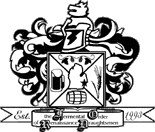 |
 |
 |
 |
 |
 |
| July 2000 | Fermental Order of Renaissance Draughtsmen | Vol. 8 No. 7 |
The next meeting will be held back at Ford Field Picnic Area number 2 on Wednesday July 26. Ford Field is north of Michigan Avenue east of Brady and south of Cherry Hill. We have picnic site #2 reserved. It is on the north side of river between the gazebo and the bridge.
[Directions to the park from the editor. To get there from the east (e.g. Ford World Headquarters) take Michigan Avenue west to Brady. Turn north on Brady and then west on Cherry Hill. The entrance to the parking lot is on the south side of Cherry Hill. From the west, take Michigan Avenue to Military. Turn north on Military. Take Military to Cherry Hill and then turn east on Cherry Hill to get to the park. If you travel north on Monroe eventually you will run into the south parking lot of the park (roughly three blocks north of Michigan Avenue.]
Here is some late breaking news from Chris Frey.
Well, with a few phones calls we have jazzed up the Wednesday meeting at Ford field in Dearborn. Jim Rice has volunteered to cook up his specialty, Teriyaki marinated chicken breasts, available for $1 each (to cover the costs of the club covering his costs). So if you plan on attending, try to bring a side dish, chips, cookies, what have you.
Also, there will be a couple of kegs of brew and Jim Racine has volunteered some of his Greektown Lager. Tyler will bring the jockey box, so feel free to bring a keg, some bottles or even some interesting commercial brews.
See ya there!
The winners from the German Lager Competition are:
| German Lager Competition | |||
| Place | Name | Style | Points |
| 1 | Rich Hampo | Helles | 40/50 |
| 2 | Jim Rice | North German Pilsner | 32/50 |
| 3 | Jim Racine | Vienna | 28/50 |
The winners from the Porter Competition are:
| Porter Competition | |||
| Place | Name | Style | Points |
| 1 | Mike Arend | Robust Porter | 37/50 |
| 2 | Gary Shewchuk | Brown Porter | 34/50 |
| 3 | Kathy Loftus and Doug Geiss | Coffee Brown Porter | 32/50 |
| 3 | Jim Racine | Robust Porter | 32/50 |
Best of the Big Brew Club Competition will be judged at our next meeting at Ford Field Category 6a American pale Ale . If you can't make it to the meeting you can always drop the beer off with me. Jim Racine 3132775516
Please note I was mistaken last month. I thought that this category included the other pale ale categories. - Tony
Aroma: Usually moderate to strong hop aroma from dry hopping or late kettle additions of American hop varieties. Citrusy hop aroma very common. Esters vary from low to high. Diacetyl moderate to none.
Appearance:Pale golden to amber.
Flavor: Often moderate to high hop flavor. Citrusy hop flavor very common (such as from Cascades), but also other American hop variety flavors are found. Malt flavor moderate relative to aggressive hop flavor and bitterness. Balance towards bitterness. Caramel flavor is usually restrained. Diacetyl moderate to none.
Mouthfeel: Many are rather light, refreshing and more highly carbonated than many other styles, but body can reach medium. Carbonation borders on effervescent in some examples.
Overall Impression: Should be refreshing.
Comments: In the past, this category also covered what is now called American amber ale. American pale ales differ from American amber ales notably by being lighter in color, but also in having less caramel flavor and usually being balanced more towards hop bitterness.

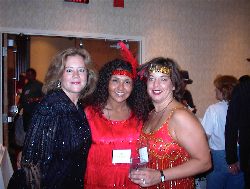 |
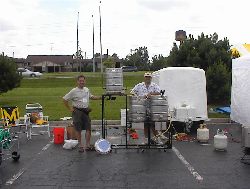 |
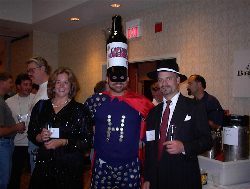 |
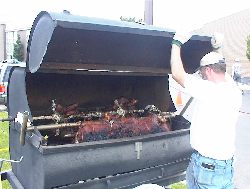 |
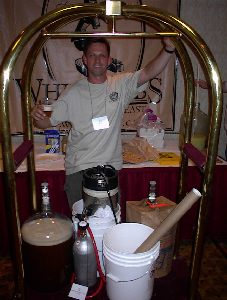 |
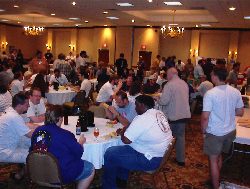 |
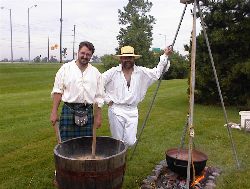 |
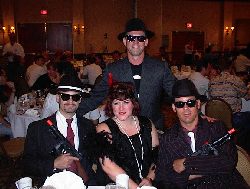 |
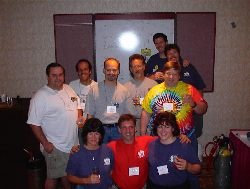 |
For more pictures click here.
For even more pictures click here.
***Important Dates***
Entries due: Monday, July 31, 2000
First Round Judging: Saturday, August 5, 2000
Best-of-Show: Saturday, August 26, 2000 at 4:30 p.m.
This year's Best-of-Show Winner receives a femto system from pico-Brewing Systems, which includes two 5-gallon 304 stainless steel kettles with copper clad bottoms, bronze valves, SS lids, copper screen and support, braided stainless steel rubber hose, and thermometer - over $350 value!
Please see our web site for details and entry instructions: http://hbd.org/michigan
The one-page entry form is attached. It's in pdf format, viewable with Adobe Acrobat Reader. Get Acrobat Reader at: http://www.adobe.com/products/acrobat/readstep.html
**Organizers**
Bill Holmes, Competition Director (the boss hog)
(734) 761-5315
mistatefair@juno.com
Jim Suchy, Registrar (the guy you send your entries to)
(734) 722-9238
grayling@provide.net
Scott Yoder, Judge Director (the guy to talk to if you want to judge)
(734) 954-0654
Additional help provided by:
Pat Babcock, Mike O'Brien and Chris Frey
*Sponsors*
This competition is made possible by:
This competition is sanctioned by the Beer Judge Certification Program
Cheers,
-Bill
Bill Holmes
118 Virginia Ave
Ann Arbor, Mi 48103
734-761-5315
Jason from the Adventures in Homebrewing Store will be taking entries for the state fair. To quote from their mailing list,
The state fair is getting close, so get in all of the brews you want to enter. We will be collecting brews until Saturday, July 29th. If you are interested in judging or just want to learn more about the judging of beer, please call me (Jason) at the store ASAP. (313) 277 2739. We still need alot of help!!!!
WWW.Homebrewing.org
Adventures in Homebrewing
23305 Ford RD
Dearborn MI 48128
313 277 BREW
I have attached the entry instructions to the paper copies of the newsletter. If you are viewing this document electronically, you can get the required forms and instructions from the previously mentioned link, http://hbd.org/michigan
Fellow Brewers,
We need judges to help with the 2000 Michigan State Fair Homebrew Competition. Last year we had 275 entries and we anticipate even more entries this year. First round judging will take place Saturday, August 5 starting at 10:30 a.m. at Frog Island Brewing Company in Ypsilanti (directions below). We need certified/recognized and national judges, but we also need experienced and novice judges, as well. We need to know if you plan to judge or steward and if there are any beer styles which you would prefer not to judge or cannot judge because you've entered beers in those categories. If you are not available on August 5, we could still use your help on other days during the week of August 7.
If you can help, please contact the Assistant Judge Director, Jason Henning, at 734-449-4795 (e-mail: jason@thehennings.com ). Note that the judge director, Scott Yoder (734-954-0654), will be out of contact next week, so you'll need to contact Jason if you plan to judge.
For more information about the Michigan State Fair Homebrew Competition, see this web page: http://hbd.org/michigan/
The Best-of-Show judging and Awards Presentation will take place Saturday, August 26 at 4:30 p.m. in the Community Arts Exhibit Hall on the Michigan State Fairgrounds. All are welcome to attend this event. Directions are available at the competition web site noted above.
Please pass this message on anyone who would be interested in judging.
Thank you,
-Bill Holmes, Competition Director
118 Virginia Ave.
Ann Arbor, MI 48103
FIRST ROUND JUDGING DATE & TIME
Saturday, August 5, 2000 at 10:30 a.m.
JUDGING LOCATION
Frog Island Brewing Company
120 East Cross Street
Ypsilanti, MI
DRIVING DIRECTIONS
* From the West or North, follow US-23 South to I-94 East.
* From the East, take I-94 West.
* From the South, follow US-23 North and go East on I-94.
From I-94, take Exit 183 and head north towards downtown Ypsilanti. Turn right on Cross Street and go through Depot Town. Frog Island Brewing Co. is on the right after the light at River St.
Ah, what a blur. Three days of fun and beer and nothing but fun and beer! If you did not get a chance to stop in and participate and enjoy the AHA National Convention in Livonia last month I have to say you missed a memorable event.
Thursday Night was the Beers Without Borders evening and what seemed like two hundred thirsty, hungry brewers from around the country converged in one (too small) conference room to enjoy the libations and eats from 18 brew clubs. Perhaps it was my Beef Beerlingione in the keg, or the stout basted turkey by Marla, or the variety of various offerings, but guys and girls, we blew them away when it came to vittles. Still, there were some awesome selections available!
Thanks go to my "Guys & Dolls", the F.O.R.D. dirty dozen, who decked out in Zoot suits, gangster outfits and flapper wear. Bob and Kim Barret, Doug Geiss and Kathy Loftus, Sue Merritt, Jim Raccine, Mark Hansen, Rich Byrnes, Connie and Kathy (my personal molls), Al Czajkowski and I burst into the room shortly after the gathering started and added a "unique flavor" to the prohibition themed gathering.I gave a little thank you speech to Charlie and paul for having picked our backyard as the site of this occassion and I believe I even kept it reasonably brief.
Door prizes galor were donated and distributed that evening and probably a quarter of the room left with something. This was followed by what became a nightly event, the Hops-itality suite, where people gathered into the wee hours of the morning.
Friday brought a few blurry eyes and the convention started in earnest. Speakers throughout the day spoke on a variety of topics and for those who could not seem to leave the Hops-itality suite, a live feed piped in the speakers onto a TV setup.
Mike O'Brien (Pico-Brewing System fame) cooked up two pigs for dinner that evening and the day was a blur.
Guys, I might have this all wrong but I think it was Saturday that David Cords and I brewed Nearly Nirvana Pale Ale #21 in the parking lot with Scott Day and Jay Emerson of the Commision brewing a Honey Porter and Mike O'Brien brewing a Spruce beer, using equipment as one one have used two hundred. More speakers, more brew.
Saturday morning the club had 11 kegs for it's two hour shift and friends, collectively we brew some awesome beer! The only other major event was the awards banquet where Pat Babcock was blind-sided and given an recognition award for maintaining the HBD and I was blind-sided and given an award for outstanding party animal for National Homebrew Day (or something like that). A special toast was raised in Bill Piffer's (spelling wrong - sentimate is right) honor for all that he had contributed to the hobby. His mead was pure nectar!
Sunday morning was a comedy of errors, hangovers and beer spooge. Enough said. It was a great time
Next month's competition style is "Lawnmower Beer". These are light beers that can be drunk during light activities (such as mowing your lawn) on hot days. There is no one particular style that monopolizes this definition, but several styles come to mind.
1. AMERICAN LAGER
1A. Light/Standard/Premium
Aroma: Little to no malt aroma. Hop aroma may range from none to light, flowery hop presence. Slight fruity aromas from yeast and hop varieties used may exist, as well as perceptible levels of green apples due to acetaldehyde. Low levels of "cooked-corn" aroma from DMS may be present. No diacetyl.
Appearance: Very pale straw to pale gold color. White head seldom persists. Very clear.
Flavor: Crisp and dry flavor with some low levels of sweetness. Hop flavor ranges from none to low levels. Hop bitterness at low to medium level. Balance may vary from slightly malty to slightly bitter, but is relatively close to even. High levels of carbonation may provide a slight acidity or dry "sting." No diacetyl. No fruitiness.
Mouthfeel: Very light body from use of a high percentage of adjuncts such as rice or corn. Very well carbonated with slight carbonic bite on the tongue.
Overall Impression: Very refreshing and thirst quenching. "Light" beers will have a lower gravity and less resulting alcohol than the standard. Premium beers tend to have fewer adjuncts or can be all-malt.
Ingredients: Two- or six-row barley with high percentage (up to 40%) of rice or corn as adjuncts.
Vital Statistics: OG: 1.035-1.050
IBUs: 8-22 FG: 0.098-1.012
SRM: 2-8 ABV: 3.5-5.1%
Commercial Examples: Standard: Budweiser, Molson Golden, Kirin, Corona, Fosters; Premium: Michelob; Light: Bud Light, Miller Lite.
1B. Dark
Aroma: Little to no malt aroma. Little or no roast malt aroma since the color is usually derived artificially from the addition of dark caramel brewing syrups. Hop aroma may range from none to light flowery hop presence. Slight fruity aromas may exist from yeast and hop varieties used. Low levels of "cooked-corn" aroma due to DMS may be noticeable. No diacetyl.
Appearance: Deep copper to dark brown with bright clarity. Foam stand may not be long lasting.
Flavor: Crisp with some low levels of sweetness. Roasted malt flavors, very low to none; often the dark color is from dark caramel brewing syrups rather than roasted malts. Hop flavor ranges from none to low levels. Hop bitterness at low to medium levels. No diacetyl. No fruitiness.
Mouthfeel: Light to somewhat medium body. Smooth, although a well-carbonated beer.
Overall Impression: A colored version of lighter American lagers with little or no dark malts used. Somewhat sweeter than its pale cousins with a little more body.
Ingredients: Two- or six-row barley, corn or rice as adjuncts and potentially artificially colored with dark caramel brewing syrups.
Vital Statistics: OG: 1.040-1.050
IBUs: 14-20 FG: 1.010-1.012
SRM: 10-20 ABV: 4.1-5.1%
Commercial Examples: Michelob Dark, Lowenbrau Dark, Beck's Dark, Saint Pauli Girl Dark.
1C. Classic American Pilsner
Aroma: Low to medium clean, grainy and sweet maltiness may be evident. Medium to high hop aroma, often classic noble hops. No fruitiness or diacetyl. Some "cooked-corn" aroma due to DMS may be noticeable.
Appearance: Light to gold color. Substantial, long lasting head. Bright clarity.
Flavor: Medium to high maltiness similar to the Bohemian Pilsners but somewhat lighter due to the use of up to 30% flaked maize (corn) used as an adjunct. Slight grainy sweetness from the use of maize with substantial offsetting hop bitterness. Medium to high hop flavor from noble hops. Medium to high hop bitterness. No fruitiness or diacetyl.
Mouthfeel: Medium body and rich, creamy mouthfeel. Medium to high carbonation levels.
Overall Impression: A substantial Pilsner that can stand up to the classic European Pilsners, but exhibiting the native American grains and water available to German brewers who initially brewed it in the USA. Refreshing, but with the underlying malt and hops that stand out when compared to other modern American light lagers. The maize presents a unique grainy sweetness that is indicative of the style.
History: A version of Pilsner brewed in the USA by immigrant German brewers who brought the process and yeast with them when they settled in America. They worked with the ingredients that were native to America to create a unique version of the original Pilsner. This style died out with Prohibition but was resurrected as a home-brewed style by advocates of the hobby.
Comments: The classic American Pilsner was brewed both pre-Prohibition and post-Prohibition with some differences. OGs of 1.050-1.060 would have been appropriate for pre-Prohibition beers while gravities dropped to 1.044-1.049 after Prohibition. Corresponding IBUs dropped from a pre-Prohibition level of 25-40 to 20-35 after Prohibition.
Ingredients: Six-row barley with 20% to 30% flaked maize to dilute the excessive protein levels. Native American hops such as Clusters or traditional noble German hops. Modern Hallertau crosses (Ultra, Liberty,Crystal) are also appropriate.
Vital Statistics: OG: 1.044-1.060
IBUs: 25-40 FG: 1.010-1.015
SRM: 3-6 ABV: 4.5-6%
Commercial Examples: None.
3. LIGHT ALE
3A. Blond Ale
Aroma: Some fruitiness; may have low to medium hop bouquet, principally from American hop varieties. Light maltiness. Low diacetyl OK.
Appearance: Pale straw to deep gold in color. Clear to brilliant. Good head retention.
Flavor: Soft, lightly malty palate, some fruitiness and hop flavor present. Usually balanced with a light to medium bitterness, though the accent tilts towards malt. Hop bitterness low to medium, although some versions are very restrained with hops, making the beer sweet in character. Low levels of diacetyl acceptable.
Mouthfeel: Medium body, though lighter mouthfeel from higher carbonation may be noticed.
Overall Impression: This beer is generally balanced with light hops and malt as an introduction to alternate beer styles for the mass-market beer consumer.
History: Currently produced by (American) microbreweries and brewpubs.
Ingredients: Generally all malt.
Vital Statistics: OG: 1.045-1.060
IBUs: 15-33 FG: 1.008-1.015
SRM: 2-8 ABV: 4-6%
Commercial Examples: Catamount Gold, Goose Island Blonde, Bridgeport Pintail Ale.
3B. American Wheat
Aroma: Characteristic of wheat with some graininess. Bavarian Weizen’s clovey and banana aromas are inappropriate. Hop aroma may be high or low but if present will be from American hop varieties.
Appearance: Usually pale straw to gold. Dark versions approximating Dunkel Weizens are acceptable. Clarity may range from brilliant to hazy with yeast approximating the hefe Weizen style of beer. Big, long-lasting head.
Flavor: Light graininess. Bavarian Weizenbier flavors such are banana esters and clove-like phenols are inappropriate. Hop flavor may be from low to high. Hop bitterness low to medium. Some fruitiness from ale fermentation acceptable; however, the use of a fairly neutral American ale yeast usually results in a clean fermentation. Little to no diacetyl.
Mouthfeel: Light to medium body. Higher carbonation is appropriate. Mouthfeel will appear lighter than actual body due to higher levels of carbonation.
Overall Impression: A light, refreshing beer that exhibits balanced hop and wheat maltiness.
Ingredients: Standard ale yeast. Often 50% wheat malt or more.
Vital Statistics: OG: 1.035-1.055
IBUs: 10-30 FG: 1.008-1.015
SRM: 2-8 ABV: 3.7-5.5%
Commercial Examples: Otter Creek Summer Wheat, Anchor Wheat, Boulevard Wheat, Pyramid Hefe-Weizen.
3C. Cream Ale
Aroma: Low hop aroma may be present. Low levels of DMS acceptable. Low maltiness. Some character from the use of corn as an adjunct may be present.
Appearance: Pale straw to pale gold. Clear to brilliant. Good head retention.
Flavor: Low hop bittering. Low maltiness; however, grainy sweetness from corn may be present. Low levels of fruitiness OK. Balanced, clean fermentation. No diacetyl.
Mouthfeel: Light body. Well carbonated. Smooth mouthfeel.
Overall Impression: A light, refreshing, thirst-quenching beer.
History: Adaptation of American light lager. Fermented as an ale, followed by cold conditioning or a blending of ale and lager beers, which reduces the fermentation byproducts.
Ingredients: Corn or rice is often used as adjuncts.
Vital Statistics: OG: 1.044-1.055
IBUs: 10-22 FG: 1.007-1.010
SRM: 2-4 ABV: 4.4-5.7%
Commercial Examples: Genesee Cream Ale, Little Kings Cream Ale.
10. BROWN ALE
10A. Mild
Aroma: Slight mild malt/brown malt aroma, with some fruitiness. No hop aroma.
Appearance: Medium to dark brown or mahogany color. A few light brown examples exist. May have very little head due to low carbonation.
Flavor: Malty, though not roasty, with a lightly nutty character. Flavors may include: vinous, licorice, plum or raisin, or chocolate. Usually fairly well balanced, though some are sweetly malt-oriented.
Mouthfeel: Light to medium body. Low carbonation and relatively high residual sweetness contribute to a full mouthfeel relative to the gravity.
Overall Impression: A light-flavored, malt-accented beer that is readily suited to drinking in quantity. Refreshing, yet flavorful.
History: May have evolved as one of the elements of early porters. In modern terms, the name "mild" refers to the relative lack of hop bitterness, Originally, the “mildness” may have referred to the fact that this beer was young and did not yet have the moderate sourness that aged batches had.
Ingredients: English mild/brown malt, or a combination of English pale and darker malts should comprise the grist. English hop varieties would be most suitable, though their character is muted.
Vital Statistics: OG: 1.030-1.038
IBUs: 10-20 FG: 1.008-1.013
SRM: 10-25 ABV: 2.5-4.0%
Commercial Examples: Brain’s Dark, Banks's Mild, Highgate Mild, Fuller's Hock, McMullin AK, Robinson's Best Mild.
17. WHEAT BEER
17A. Bavarian Weizen
Aroma: Vanilla and clove-like phenols and fruity esters of banana are common. Hop aroma ranges from low to none. No diacetyl. Some aroma of wheat may be present.
Appearance: Pale straw to dark reddish-gold in color. A very thick, long-lasting head is characteristic. High protein content of wheat may impair clarity in an unfiltered beer, and clarity can be deliberately cloudy in a Hefe-Weizen from suspended yeast sediment. The filtered Krystal version is quite clear.
Flavor: The soft, grainy flavor of wheat is essential. Hop flavor is low to none and hop bitterness is very low. A tart character from yeast and high carbonation may be present. Spicy clove phenols and fruity esters, most prominently banana, are often present. No diacetyl.
Mouthfeel: The texture of wheat imparts the sensation of a fluffy, creamy fullness that may progress to a surprisingly light finish. A high carbonation level is typical.
Overall Impression: A pale, spicy, fruity, wheat-based ale.
History: A traditional wheat-based ale from Southern Germany that is a specialty for summer consumption.
Comments: These are refreshing, fast-maturing beers that are lightly hopped. The Hefe-Weizen version is served with yeast sediment stirred into it. The Krystal version is filtered for excellent clarity.
Ingredients: A high percentage of malted wheat is used which typically constitutes 50% or more of the grist, the remainder being pale barley malt. Weizen ale yeast produces the typical spicy and fruity essences during a relatively warm fermentation. Hops are used for a small amount of bittering only. Water character will vary.
Vital Statistics: OG: 1.040-1.056
IBUs: 10-20 FG: 1.010-1.014
SRM: 2-9 ABV: 4.3-5.6%
Commercial Examples: Paulaner Hefe-Weizen, Pschorr-Brau Weisse, Spaten Club-Weisse, Schneider Weisse, Julius Echter Weizenbier.
17B. Bavarian Dunkelweizen
Aroma: Gentle aroma of Munich malt supported by fruity, notably banana, and clove-spice aromas. No hop aroma. No diacetyl.
Appearance: Light amber to light brown in color. A thick, long-lasting head is characteristic. High protein content of wheat may impair clarity in an unfiltered beer.
Flavor: Melanoidins and caramel character of Munich and Vienna-type malts is prominent, along with some wheat flavor. There may be some spicy, fruity flavor as well. Roasty character is rare and very restrained if present. Low hop bitterness. No hop flavor. No diacetyl.
Mouthfeel: The texture of wheat imparts the sensation of a fluffy, creamy fullness that may progress to a lighter finish. However, the presence of Munich and Vienna-type malts provides its own sense of fullness. A moderate to high carbonation level is typical.
Overall Impression: A dark, malty, spicy, wheat-based ale.
History: A dark version of Bavarian Weizen.
Comments: The presence of Munich and Vienna-type barley malts gives this style a deeper and richer barley malt character than Bavarian Weizen. Often, there is less of the tart quality as well.
Ingredients: Wheat malt typically makes up 50% or more of the grist, the remainder being Munich or Vienna-type high-kilned barley malts. Some dark wheat malts may be used. Dark roasted malts are rarely used and then only in very small concentrations. Hops provide a mild bitterness only. Weizen ale yeast is used. Water character will vary.
Vital Statistics: OG: 1.040-1.056
IBUs: 10-20 FG: 1.010-1.014
SRM: 10-23 ABV: 4.3-5.6%
Commercial Examples: Pschorr-Brau Dunkel Weiss, Franziskaner Dunkel-Weizen, Schneider Dunkel Weiss.
17C. Berliner Weisse
Aroma: Slightly fruity; a sour aspect may be quite noticeable. On occasion a mild Brettanomyces yeast aroma may be present. No hop aroma. No diacetyl.
Appearance: Very pale straw in color. Clarity ranges from fair to cloudy. Despite high carbonation, head retention can vary from moussy to low.
Flavor: Lactic sourness dominates and can be quite strong, but some wheat flavor should be noticeable. Hop bitterness is very low. Mild Brettanomyces yeast character may be detected occasionally. No hop flavor. No diacetyl.
Mouthfeel: Light body. High carbonation.
Overall Impression: A very pale, sour, refreshing, low-alcohol wheat ale.
History: A regional specialty of Berlin; referred to by Napoleon's troops in 1809 as "the Champagne of the North" due to its lively and elegant character.
Comments: Often served with the addition of sugar syrups flavored with raspberry or woodruff to counter the substantial sourness. Has been described by some as the most purely refreshing beer in the world.
Ingredients: Wheat malt content is typically well under 50% of the grist, the remainder being pale barley malt. Lactobacillus delbruckii culture and fermentation provides the sharp sourness, which may be enhanced by blending of beers of different ages during fermentation and by extended cool aging. Ale yeast ferments to a low alcohol level. Hop bitterness is extremely low. Water may have significant hardness.
Vital Statistics: OG: 1.026-1.036
IBUs: 3-8 FG: 1.006-1.009
SRM: 2-4 ABV: 2.8-3.6%
Commercial Examples: Schultheiss Berliner Weisse, Berliner Kindl Weisse.
19. BELGIAN AND FRENCH ALE
19B. Witbier
Aroma: A sweet and occasionally honey-like character with prominent citrus (notably orange), herbal and spice aromas is characteristic, and is often followed by a mild phenolic aroma. Hop aroma is low to none. No diacetyl.
Appearance: Very pale straw to very light gold in color, and generally cloudy. Head retention should be quite good and of a moussy character.
Flavor: The flavor of unmalted wheat is typically noticeable. Coriander, citrus and mild phenolic flavors contribute to a complex and elegant character. A very slight lactic acidity resulting from a limited Lactobacillus fermentation is present in some examples, providing a refreshing quality, and is absent in others. Hop flavor is low to none. Hop bitterness is typically restrained, and some bitterness may also be contributed by bitter orange peel. No diacetyl.
Mouthfeel: Light to medium body. Effervescent character of high carbonation. Refreshing acidity.
Overall Impression: A refreshing, elegant, complex, wheat-based ale.
History: A 400-year-old beer style that died out in the 1950s, it was revived by Pierre Celis in the 1960s to steadily growing popularity thereafter.
Comments: The presence and degree of spicing and lactic sourness vary from one brand or brewery to another.
Ingredients: About 50% unmalted hard red winter wheat and 50% pale barley malt constitute the grist; in some versions a small percentage of raw oats is used as well. Spices of freshly-ground coriander and dried orange peel complement the sweet aroma and are quite characteristic; other spices may be used for complexity but are much less prominent. Ale yeast prone to production of mild, clovey/spicey flavors are very characteristic. In some instances a very limited Lactobacillus fermentation, or actual addition of lactic acid, is done.
Vital Statistics: OG: 1.042-1.055
IBUs: 15-22 FG: 1.008-1.012
SRM: 2-4 ABV: 4.2-5.5%
Commercial Examples: Celis White, Hoegaarden Wit, Steendonk Witbier, Brugs Tarwebier, Blanche de Bruges.
21. FRUIT BEER
Aroma: The character of the particular fruit(s) should be distinctive in the aroma. Overall the aroma should be a balanced combination of malt, hops and the featured fruit(s) as appropriate to the specific type of beer being presented. If the base beer is an ale then general fruitiness and other fermentation byproducts such as diacetyl may be present as appropriate for the warmer fermentation. If the base beer is a lager, then overall less fermentation byproducts would be appropriate. Some malt aroma preferable, especially in dark styles; hop aroma absent or balanced with fruit, depending on the style. The overall aroma should be balanced and harmonious.
Appearance: Appearance should be appropriate to the base beer being presented and will vary depending on the base beer. For lighter beers with fruits that exhibit distinctive colors, the color should be noticeable.
Flavor: The character of the particular fruit(s) should be distinctive in the flavor profile. Hop bitterness, flavor, malt flavors, alcohol content and fermentation byproducts, such as diacetyl, should be appropriate to the base beer and harmonious and balanced with the distinctive fruit flavors present.
Mouthfeel: Mouthfeel may vary depending on the base beer selected and as appropriate to that base beer. Body and carbonation levels should be appropriate to the base beer style being presented.
Overall Impression: A harmonious marriage of fruit and beer.
Comments: Overall balance is the key to presenting a well-made fruit beer. The fruit should complement the original style and not overwhelm it. The brewer should recognize that some combinations of base beer styles and fruits work well together while others do not make for harmonious combinations. The entrant must specify the underlying beer style as well as the type of fruit(s) used. If the base beer is a classic style, the original style should come through in aroma and flavor. Judges should remember that many fruits dry out classic styles.
Vital Statistics: OG, FG, IBUs, SRM and ABV will vary depending on the underlying base beer.
Commercial Examples: Oxford Raspberry Wheat, Oregon Blackberry Porter, Pyramid Apricot Ale, Rogue 'n' Berry, Brimstone Blueberry Wheat, Oaken Barrel Raspberry Wheat.
22. SPICE/HERB/VEGETABLE BEER
Aroma: The character of the particular spices, herbs and/or vegetables (SHV) should be distinctive in the aroma. Overall the aroma should be a balanced combination of malt, hops and the featured SHV(s) as appropriate to the specific type of beer being presented. If the base beer is an ale then general fruitiness and other fermentation byproducts such as diacetyl may be present as appropriate for the warmer fermentation. If the base beer is a lager, then overall less fermentation byproducts would be appropriate. Some malt aroma preferable, especially in dark styles; hop aroma absent or balanced with the SHVs used, depending on style. The overall aroma should be balanced and harmonious.
Appearance: Appearance should be appropriate to the base beer being presented and will vary depending on the base beer. For lighter beers with spices, herbs or vegetables that exhibit distinctive colors, the colors should be noticeable.
Flavor: The character of the particular SHV(s) should be distinctive in the flavor profile. Hop bitterness, flavor, malt flavors, alcohol content, and fermentation byproducts, such as diacetyl, should be appropriate to the base beer and harmonious and balanced with the distinctive SHV flavors present.
Mouthfeel: Mouthfeel may vary depending on the base beer selected and as appropriate to that base beer. Body and carbonation levels should be appropriate to the base beer style being presented.
Overall Impression: A harmonious marriage of spices, herbs and/or vegetables and beer.
Comments: Overall balance is the key to presenting a well-made spice, herb or vegetable (SHV) beer. The SHV should complement the original style and not overwhelm it. The brewer should recognize that some combinations of base beer styles and SHVs work well together while others do not make for harmonious combinations. The entrant must specify the underlying beer style as well as the type of SHV(s) used. If the base beer is a classic style, the original style should come through in aroma and flavor. Additionally, whenever multiple spices, herbs or vegetables are used each should be distinctive in their own way.
Vital Statistics: OG, FG, IBUs, SRM and ABV will vary depending on the underlying base beer.
Commercial Examples: Harpoon Winter Warmer, Ed's Cave Creek Chili Beer, Buffalo Bill's Pumpkin Ale, Anchor Our Special Ale, Wild Onion Pumpkin Ale.
23. SMOKE-FLAVORED BEER
24. SPECIALTY/EXPERIMENTAL/HISTORICAL
Any ale or lager beer brewed using unusual techniques (hot rocks, etc.), unique fermentables (such as maple syrup, honey, etc.),unique adjuncts (oats, rye, potatoes, etc.), low alcohol, combinations of fruits and spices/herbs/vegetables, or historical beers (Entire, IPA with Brettanomyces, Louvain Peeterman, etc.). Experimental beers that do not otherwise meet the other established style categories may be entered here.
Aroma: The character of the stated uniqueness should be distinctive in the aroma. Overall the aroma should be a balanced combination of malt, hops and the featured uniqueness as appropriate to the specific type of beer being presented. If the base beer is an ale then general fruitiness and other fermentation byproducts such as diacetyl may be present as appropriate for the warmer fermentation. If the base beer is a lager, then overall less fermentation byproducts would be appropriate. The overall aroma should be balanced and harmonious.
Appearance: Appearance should be appropriate to the base beer being presented and will vary depending on the base beer.
Flavor: The character of the particular ingredient or technique should be distinctive in the flavor profile. Hop bitterness and flavor, malt flavors, alcohol content and fermentation byproducts, such as diacetyl, should be appropriate to the base beer and harmonious and balanced with the distinctive nature of flavors present.
Mouthfeel: Mouthfeel may vary depending on the base beer selected and as appropriate to that base beer. Body and carbonation levels should be appropriate to the base beer style being presented.
Overall Impression: A harmonious marriage ingredients, processes and beer.
Comments: Overall balance is the key to presenting a well-made specialty beer. The distinctive nature of the stated specialty should complement the original style and not overwhelm it. The brewer should recognize that some combinations of base beer styles and ingredients or techniques work well together while others do not make for harmonious combinations. The brewer must specify the underlying beer style as well as the type of unique ingredients used, process utilized or historical beer style being brewed. If the base beer is a classic style, the original style should come through in aroma and flavor. Additionally, whenever multiple fruits, spices, herbs or vegetables are used each should be distinctive in their own way. For historical styles that may not be known to all beer judges, the brewer may provide a copy of the text of references to these beers as an aid to the judges.
Vital Statistics: OG, FG, IBUs, SRM and ABV will vary depending on the underlying base beer.
| Beer Events, Meetings & Competitions
Gabrielle Palmer |
 |
| Fermental Funny |
Quote from HBD 7/12/00
GAME SHOW HOST TO CONTESTANT:
"What would you do if you won the million dollars ?"
CONTESTANT (male):
"Well ......., I guess I would spend the first $900,000 on women and beer, and then basically just waste the rest"
| Ye Olde Brew News
published by the F.O.R.D. Homebrew Club |
|
| Editor:
Tony Tantillo Contributors:
Club Officers:
|
F.O.R.D. is a private, non-profit organization of homebrewers. The main goal of this club is to
promote awareness and appreciation of the quality and variety of beer; to share information regarding technique, equipment and skill
required to brew quality homemade beer; and to encourage responsible use of beer as an alcohol-containing beverage.
Correspondence should be directed to:
Phone: 810-795-0512
Visit our website at: http://www.be.ford.com/brewers/
current circulation... 125 |